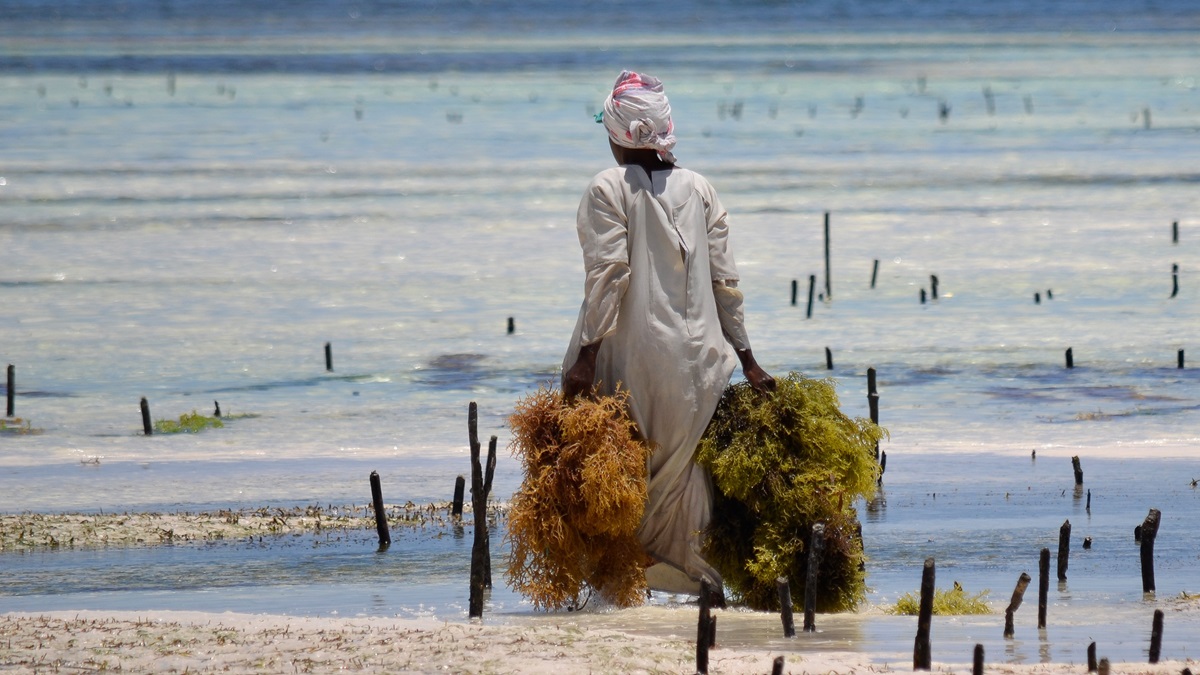A global shift towards non-plastic materials holds significant potential to deliver economic opportunities for the developing world.
© Shutterstock/Matthias Kestel | A seaweed farmer in Zanzibar, Tanzania. The marine algae can potentially replace plastics in various products including packaging.
A new database tracking international trade in non-plastic substitutes is now available on UN Trade and Development’s (UNCTAD) online Data Hub.
Such materials can be minerals, wood pulp, or natural fibres like cotton, bamboo and seaweed. They can be used to make more environmentally friendly versions of the shopping bags, utensils, wrappers and other plastic products we consume daily.
The database comes as United Nations-led negotiations are underway between 25 November and 1 December 2024 in Busan, the Republic of Korea, to develop a global treaty aimed at ending plastic pollution to safeguard human and planetary health. These negotiations will be a hard test of the political will needed to tackle this global threat to all life on Earth.
The database allows users to track evolving patterns of global trade in non-plastic substitutes based on export values reported by member states.
“This statistical series, anchored in customs data reported by nearly all countries, can help foster data-informed strategies to drive circular economy practices and sustainable development,” says Anu Peltola, director of UNCTAD Statistics.
“The new data aims to raise awareness of the availability of material options other than plastics, as member states face challenges in negotiating a treaty to eliminate plastic pollution, omnipresent in our value chains,” says Chantal Line Carpentier, head of the Trade, Environment and Climate Branch at UNCTAD.
“It is also key to enabling innovation and product design of non-plastic substitutes with potential to reduce pollution and greenhouse gas emissions.”
Untapped potential in a multi-billion-dollar market
Exports of plastics or goods made from plastic, valued at a record high of $1.2 trillion in 2022, continue to loom large in international trade.
But as markets increasingly prioritize sustainability, non-plastic substitutes are gaining ground.
In 2022, global exports in non-plastic substitutes reached $560 billion in value, growing slightly faster than that of plastics trade.
In terms of value distribution, raw materials – primarily minerals and natural fibers derived from forestry resources as well as seaweed – account for more than two thirds of non-plastic substitutes trade.
Finished products, in comparison, only comprise the remaining one-third share, signaling a need for incentives towards more value-added activities in the sector.
How developing economies can unlock more opportunities
The UNCTAD database shows that global trade in non-plastic substitutes is largely dominated by developed economies.
Geographically, Asia and Europe lead global non-plastic substitutes exports in value terms (accounting for 35% and 37%, respectively), backed by strong intra-regional trade. Africa's participation is notably small, currently under 3%.
Beyond environmental benefits, the shift towards non-plastic substitutes can catalyze efforts to bolster and diversify exports, create quality jobs and enhance productive capacities.
But many developing economies lack the necessary technologies and capacities to produce value-added products on a large scale.
UN Trade and Development supports innovation in developing countries through its Sustainable Manufacturing and Environmental Pollution (SMEP) programme.
It advocates for more targeted investments in local value addition, research and development, innovation and international cooperation to help developing economies fully engage in non-plastic substitutes trade.
Note: When the article was published on 24 November, estimates based on data available indicated that global exports of non-plastic materials were worth $831 billion in 2022. On 14 March, the figure was revised to $560 billion due to refinements in the classification of HS codes and improvements in data accuracy, leading to a more precise assessment of trade flows.

